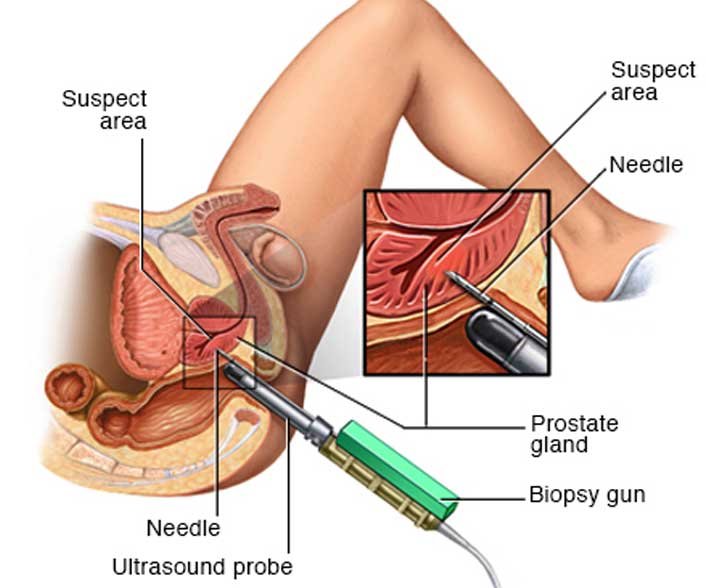
Prostate Biopsy
A Prostate biopsy is a procedure to remove samples of suspicious tissue from the prostate. During a prostate biopsy, also called a core needle biopsy, a fine needle is used to collect a number of tissue samples from your prostate gland.A prostate biopsy is done by an urologist, a doctor who specializes in the urinary system. Following a prostate biopsy, tissue samples from the prostate biopsy are examined under a microscope for cell abnormalities that are a sign of prostate cancer. If cancer ispresent, it is evaluated to determine how quickly it's likely to grow and spread, and to determine your best treatment options.
Whyit's done: - A prostate biopsy isused to detect prostate cancer. Your doctor may recommend a prostate biopsy if:
· Resultsof a prostate-specific antigen (PSA) test are higher than normal for your age.
· Yourdoctor found lumps or other abnormalities during a digital rectal exam.
· Aprevious biopsy revealed prostate tissue cells that were abnormal but notcancerous.
Risks:- Common risks associated with a prostate biopsyinclude:
· Infection. The most common risk associated with a prostate biopsy isinfection. Rarely, men who have a prostate biopsy develop an infection of theurinary tract or prostate that requires treatment with antibiotics.
· Bleedingat the biopsy site. Bleeding iscommon after a prostate biopsy. Don't start taking any blood-thinningmedications after your biopsy until your doctor says it's OK.
· Bloodin your semen. It's common tonotice red or rust coloring in your semen after a prostate biopsy. Thisindicates blood, and it's not a cause for concern. Blood in your semen maypersist for four to six weeks after the biopsy.
· Difficultyurinating. In some men prostate biopsy can causedifficulty passing urine after the procedure. Rarely, a temporary urinarycatheter must be inserted.
Howyou prepare: - To prepare you foryour prostate biopsy, your urologist may have you:
· Stoptaking medication that can increase the risk of bleeding, such as warfarin(Coumadin), non-steroidal anti-inflammatory medications (NSAIDs), such asaspirin and ibuprofen, and certain herbal supplements for several days beforethe procedure
· Takeantibiotics 30 to 60 minutes before your prostate biopsy, to help preventinfection.
Results
A doctor whospecializes in diagnosing cancer and other tissue abnormalities will evaluatethe prostate biopsy samples. This doctor (a pathologist) can tell if the tissueremoved is cancerous and, if cancer is present, estimate how aggressive it is.The pathologist compiles the laboratory findings in a pathology report that'sgiven to your doctor. Your doctor will explain the findings to you and, if youlike, you can ask for a copy of your pathology report for future reference.
Your pathology reportmay include:
· Informationabout your medical history. A pathologyreport may include a discussion of your medical history and any other teststhat prompted your doctor to recommend a prostate biopsy.
· Adescription of the cells. This section ofthe pathology report describes how the cells appear under a microscope.Prostate cancer cells may be referred to as adenocarcinoma in a pathologyreport. Sometimes the pathologist finds cells that appear abnormal but aren'tcancerous. Words used in pathology reports to describe these noncancerousconditions include prostatic intraepithelial neoplasia and atypical smallacinar proliferation. If the pathologistfinds cancer, it's graded on a scale called the Gleason score. This scale rateshow different the cancer cells are from normal tissue. The lowest rating is 2and the highest is 10. Cancers with a high Gleason score are the most abnormaland are more likely to grow and spread quickly.
· The pathologist's diagnosis: This section of the pathology report lists the pathologist's diagnosis. It may also include comments, such as whether other tests are recommended.·
NewNon-surgical treatment
for BenignProstatic Hyperplasia (BPH) or enlarged prostate
ByProstatic Artery Embolization (PAE)
The patients are admitted to the hospital onthe day of the procedure. Embolizationis performed under local anesthesia by right femoral artery. Initially pelvicangiography is performed to evaluate the prostatic arteries. Then, an angiographycatheter is introduced to catheterize the prostatic vessels. For embolization,PVA particles are used which causes slow flow or near-stasis in the prostaticvessels with interruption of the arterial flow.
Advantagesof Prostatic Artery Embolization (PAE)
· It does not producethe side effects that TURP does and makes for faster recovery.
· PAE can be performed on any size prostate,
· Whole procedure donethrough a small nick around the skin in the groin region.
· No sexual dysfunctionfollowing prostatic artery embolization and a quarter of patients report thatsexual function improved after the procedure.
· PAE procedure neededno general anesthesia / No blood loss or risk of blood transfusion.
· No surgical ugly scarsand makes for faster recovery with 98% success rate.
Low cost non-surgicaltreatment of enlarged prostate in Delhi, India as compare to other cities ofIndia like Mumbai, Bangalore, Chennai Ahmedabad,Hyderabad, Pune.
For more in-depth information contact: